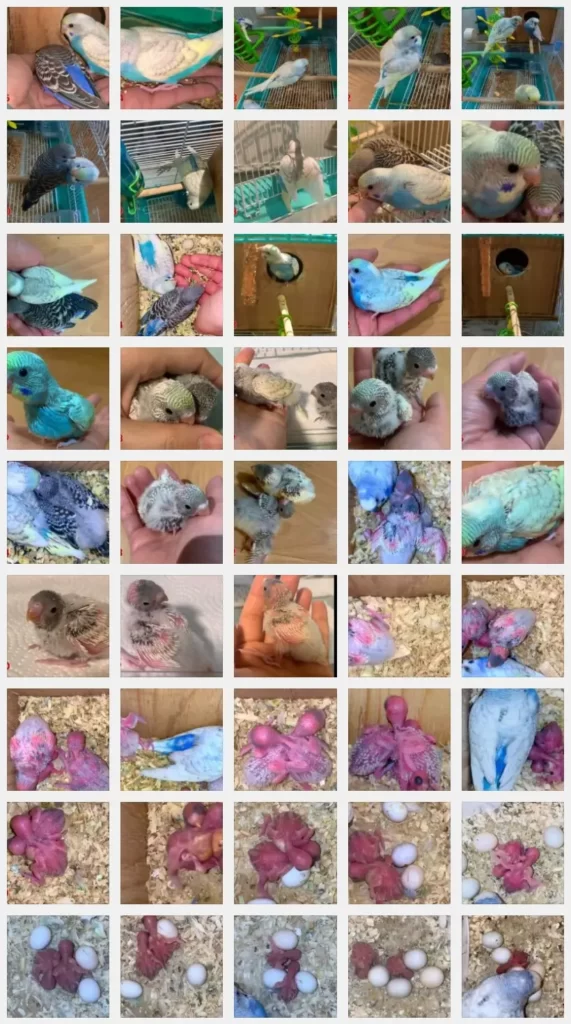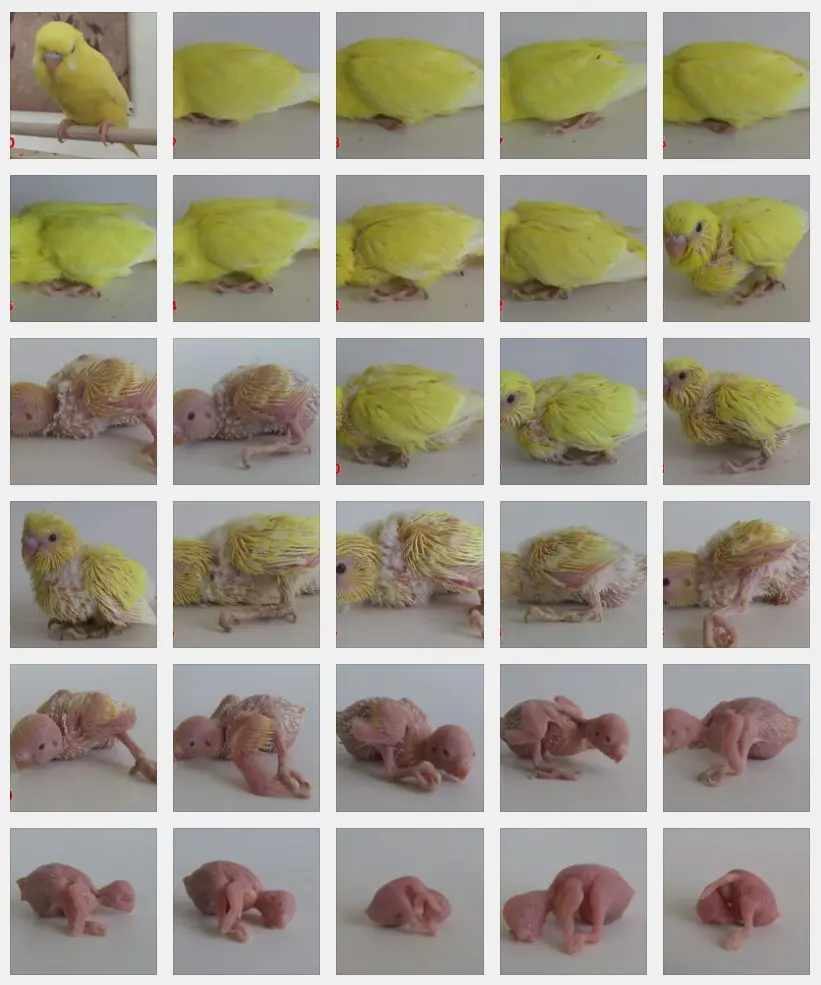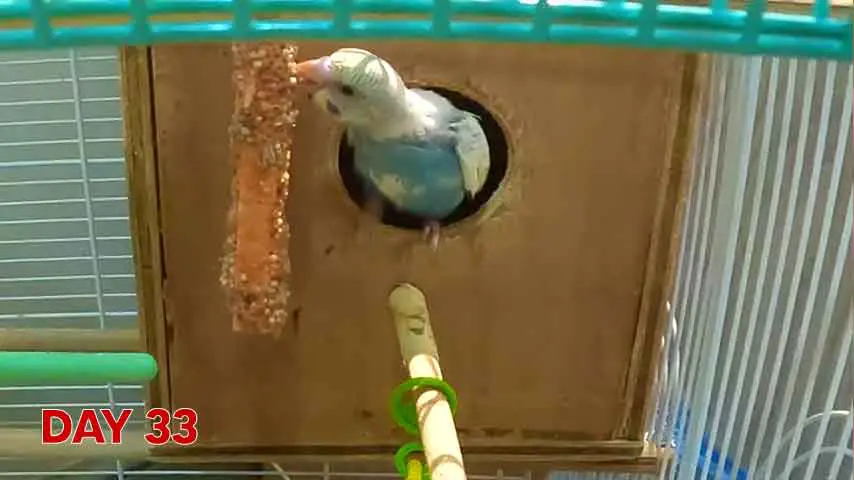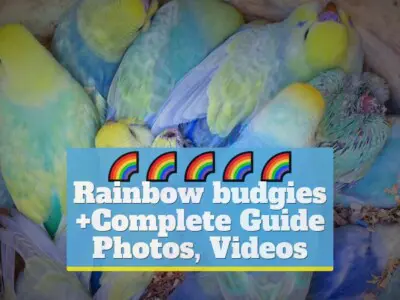‘Budgie Nesting 101’ is a comprehensive guide that offers beginners an in-depth look into the world of budgie nesting.
It covers all stages from pre-nesting behaviors, egg laying, incubation, chick growth, post-nesting care, common issues, and answers to FAQs.
Budgies are wonderful companions whose charm lies not just in their bright plumage but also their interesting breeding and nesting habits.
As a budgie lover and former owner, I’ve created this comprehensive guide to help you navigate your budgie’s nesting journey.
This Budgie Nesting 101 guide is packed with insights and tips drawn from my personal experience and observations.
From creating an ideal nesting environment to understanding the nesting cycle, to egg laying and caring for fledglings, it’s a one-stop resource for all your budgie nesting queries.
As per a study (archived) conducted by the University of Natural Sciences and Humanities in Poland, understanding the hatching and reproductive rates of budgerigars in captivity is essential not just for successful breeding but also to further our knowledge of these popular pets.
Creating the Ideal Nesting Environment
As a budgie parent, you’d know that creating the ideal nesting environment is pivotal for successful budgie breeding.
Much like us humans, budgies too need their personal space, their cozy nooks, especially when it comes to laying eggs and raising their chicks.
An overcrowded or inadequate environment, akin to an aviary, can lead to tension and fights, affecting the overall wellbeing of your budgie.
What your feathered friends truly need are cabinets.
Think of these as pigeon holes, designed to provide one pair of budgies their private residence.
A nesting box is attached to the exterior of each cabinet, equipped with a hinged lid that permits you to peek inside and monitor its contents.
These cabinets, available at your local bird shops, can be procured separately or in rows.
Choosing the Right Nest Box
Choosing the right nest box forms a critical part of setting up your budgie’s nesting environment.
Now, what constitutes a ‘right’ nest box may vary depending upon your budgie pair and their specific needs.
However, a few aspects remain constant: safety, comfort, and accessibility for monitoring.
Your nest box should be made of safe materials, free from any harmful substances that might hurt your budgies.
It should be spacious enough for your budgie pair to move around comfortably and raise their chicks.
The box should also have a hinged lid, allowing you easy access for periodic checks and cleanings.
Proper Placement of the Nest Box
After selecting the perfect nest box, the next step involves its proper placement.
While you might be inclined to place it anywhere in the cabinet, remember that the location of the nest box can significantly impact your budgies’ comfort and breeding success.
The nest box should be placed at a height that is comfortable for your budgies and also easy for you to monitor.
It should be well-protected from environmental elements like harsh sunlight or chilly winds.
Moreover, ensure the nest box is securely attached to prevent any accidental toppling, especially when your budgie is inside.
Nesting Materials: What’s Safe and What’s Not
Last but not least, let’s talk about nesting materials.
While your budgies might be pretty resourceful in gathering nesting materials, it’s important to know what’s safe and what’s not for them.
Safe materials for your budgies’ nest can include wood shavings, wood pellets, dried grass, dead leaves, and twigs.
These materials mimic what budgies would use in the wild and provide comfort and insulation to the eggs.
Pine sawdust, cut hay or chaff, straw, and pine needles can also be used.
However, these should be thoroughly cleaned and dried before use.
Shredded paper also makes for good nesting material, but only if it’s non-toxic and free from inks or dyes.
Remember, the comfort and safety of your budgies should always be your top priority when creating the perfect nesting environment for them.
This will not only keep them happy but also pave the way for successful breeding.
Understanding the Nesting Cycle
Stepping into the world of budgie breeding requires you to understand the nesting cycle.
It’s a fascinating journey that involves various stages: courtship, mating, egg-laying, incubation, chick rearing, and finally, the chicks leaving the nest.
Understanding these stages, along with knowing when and how to assist your budgies, can significantly enhance your breeding success.


Recognizing When Your Budgie is Ready to Nest
Detecting when your budgie is ready to nest is crucial, and there are telltale signs you can look out for.
Usually, female budgies mature and are ready to breed at around 6 to 9 months of age, although it’s advised to wait until they’re at least 10 to 12 months old for their safety and the health of the chicks.
Female budgies will begin to show a keen interest in the nesting box, spending a lot of time inside it.
They may start to display a more aggressive demeanor, particularly if you try to intrude upon their nesting area.
Another sign is a darkened cere (the area above the beak where the nostrils are located), which in females, turns a deeper brown during breeding season.
Timeline of the Nesting Cycle
Understanding the timeline of the nesting cycle can help you prepare for each stage and know what to expect.
Typically, the entire nesting process, from courtship to chicks leaving the nest, spans approximately 8 to 10 weeks.
During the courtship period, the male budgie will woo the female with sweet songs and displays of affection.
After successful courtship, mating occurs.
Approximately 8 to 10 days after mating, the female will lay her first egg.
Budgies lay one egg every alternate day until they have a clutch of around 4 to 6 eggs.
Incubation, the period when the female budgie warms the eggs to facilitate embryo development, commences as soon as the first egg is laid and lasts about 18 to 21 days.
Once hatched, the chicks, also known as hatchlings, remain in the nest for about 30 to 35 days before they become fledglings ready to leave the nest.
The nesting cycle is indeed an enchanting process, and being aware of the timeline can help you better care for your budgies during this period.
Your budgie pair will do most of the work, but your role is to provide them with the necessary support, the right environment, and plenty of nutritious food.
The Egg Laying Process
The egg-laying process in budgies is a delicate, intricate cycle that demands a calm and comfortable environment.
In this stage, the female budgie will lay an egg every other day until she has a full clutch.
Each egg will require incubation for the embryos to develop.
Understanding this process and ensuring your budgie’s well-being during this period is crucial for successful breeding.
Understanding the Egg Laying Timeline
The egg-laying timeline begins soon after mating, with the female budgie laying the first egg about 8 to 10 days post-mating.
Eggs are typically laid in the early morning hours and occur every other day until the clutch is complete, usually comprising 4 to 6 eggs.
The mother budgie will begin incubating the eggs immediately after laying the first one.
It’s vital not to disturb the eggs during this time as the mother needs to maintain a constant temperature for the embryos to develop properly.
Incubation lasts approximately 18 to 21 days, after which the chicks will begin to hatch.
How to Monitor Egg Health
Monitoring egg health is a delicate task that needs to be handled with utmost care.
The primary rule is to minimize disturbance; frequent handling or moving can distress the mother budgie and potentially harm the eggs.
If you suspect an issue with the eggs, it’s best to consult a veterinarian.
However, there are a few signs you can look out for to gauge egg health.
Healthy eggs will gradually take on a more opaque appearance as the chick develops inside.
In contrast, unfertilized or dead eggs, often referred to as ‘dud’ eggs, may remain translucent even after a week of incubation.
A process called budgie egg candling, where a bright light is held behind the egg to illuminate its contents, can be used to check for embryo development.
This process should be left to professionals or undertaken only after proper research, as it could cause damage if not done correctly.
Remember, the key to successful budgie breeding is patience, along with providing a safe, comfortable environment for the mother budgie during the egg-laying process.
Keep a close eye, but avoid causing unnecessary stress.
Above all, make sure your budgies are healthy, well-fed, and content throughout the process.
Incubation
The incubation stage is a critical part of the budgie breeding cycle.
This phase involves the mother budgie warming the eggs to provide the perfect conditions for the chick embryos to develop and grow.
It requires careful attention to maintain an optimal environment and minimize disturbances.
What Happens During Incubation
During incubation, the embryo inside the egg begins to develop into a chick.
This development process involves the formation of the chick’s body parts, starting with the spine, head, and eventually, the entire body structure, including wings and feathers.
The chick’s growth is sustained by the yolk, which serves as the main source of nutrients.
The eggshell’s pores allow oxygen to enter and carbon dioxide to exit, helping the chick breathe while it grows.
The incubation process requires a steady temperature of approximately 37.5 degrees Celsius (99.5 degrees Fahrenheit).
Any significant changes in this temperature can negatively affect the embryo’s development.
Role of the Budgie Mother During Incubation
The mother budgie plays a critical role during the incubation stage.
She provides warmth to the eggs by sitting on them to maintain the required temperature.
This process is often referred to as brooding.
The mother rarely leaves the nest during this period, leaving only for short periods to feed.
During her absence, the father budgie may take over brooding duties, although this isn’t always the case.
From Hatchlings to Fledglings
The journey from hatchlings to fledglings is an incredible transformation that happens over a relatively short period of time.
This stage is marked by rapid growth and development of the chicks.
The Growth Process of Budgie Chicks
Upon hatching, budgie chicks are blind and practically featherless, with only a thin layer of downy fluff.
In the first week, the chicks grow rapidly and their eyes begin to open.
By the second week, pin feathers start to emerge.
These immature feathers will eventually develop into full-fledged feathers.
By the third week, the chicks are usually fully feathered and start to explore the nest box.
They begin to learn how to eat on their own, although they are still being fed by their parents.
By week five to six, the chicks, now called fledglings, begin their first attempts at flying.
Once they can fly confidently and feed themselves, they are ready to leave the nest.
Monitoring the Health of the Chicks
Monitoring the health of the chicks is crucial to ensure they are growing properly.
Keep an eye on their weight gain and feather growth.
Chicks should be steadily gaining weight, and their feathers should be developing at a similar pace.
If you notice a chick is significantly smaller or not developing feathers as quickly as its siblings, it might be a sign of health issues.
Make sure the chicks are active and responsive.
If a chick is listless, not gaining weight, or showing signs of difficulty breathing, contact a veterinarian immediately.
Remember, disturbance should be kept to a minimum.
Checking on the chicks once a day is usually sufficient.
Regularly clean the nest box and ensure it is dry at all times to prevent any growth of mold or bacteria.
Providing a nutritious diet to the parent budgies is also key to the health of the chicks, as they rely on their parents for food during the early stages of their life.
When and How Chicks Leave the Nest
Around the fifth to sixth week, the chicks, now fledglings, are prepared to leave the nest.
This period, often referred to as fledging, is when the birds will make their first flight attempts.
They’ll typically spend time near the edge of the nest, flapping their wings and exploring their surroundings.
Their first flights are generally short and may seem more like controlled falls.
Patience is key during this phase as some fledglings may be more adventurous than others.
It’s important to remember that each bird develops at its own pace.

Post-nesting Stage
The post-nesting stage is equally significant in the breeding cycle.
After the chicks have left the nest, attention turns to ensuring the health of the parent birds and preparing for the potential next breeding cycle.
Caring for the Mother After Nesting
After the chicks have left the nest, the mother budgie will need time to recover from the demands of breeding.
She may appear tired and her body condition may have deteriorated due to the energy-intensive nesting period.
It is important to ensure she has a balanced and nutritious diet to regain her strength.
In this period, consider supplementing her feed with high-protein foods and fresh vegetables.
Allow her plenty of rest and keep disturbances to a minimum.
It’s essential to monitor her behavior closely and ensure she’s showing signs of improvement and getting back to her normal self.
Cleaning and Maintenance of the Nest Box
Cleaning and maintenance of the nest box is an important task after the chicks have fledged.
Thoroughly clean the nest box to remove any droppings or old nesting material.
A mild solution of bleach and water can be used to disinfect the box.
Ensure it is fully dry before putting it back.
Regular maintenance of the nest box helps to prevent the spread of disease and provides a clean environment for any future breeding attempts.
Troubleshooting Nesting Issues
Despite the best efforts, you may sometimes encounter problems during the nesting period.
Knowing how to troubleshoot these issues can ensure the health and safety of your budgies.
Common Problems and Solutions
A common problem is the mother budgie neglecting the eggs or chicks.
This can be due to inexperience or stress.
If this happens, you may need to intervene by providing supplemental heat for the eggs or hand-rearing the chicks.
Another issue can be infertility.
If the eggs do not hatch within 21 days, they are likely infertile.
Infertility can be caused by a poor diet, stress, or a lack of bonding between the pair.
Lastly, sibling competition can be a concern.
Older or stronger chicks may outcompete their siblings for food, leading to the smaller ones not getting enough nutrition.
Monitoring the chicks’ health and providing supplemental feeding if needed can help.
Summarizing the Budgie Nesting Journey
The budgie nesting journey is a comprehensive cycle that starts with the preparation for nesting and ends with the chicks becoming independent fledglings.
From understanding the budgie’s readiness to nest, observing the egg-laying process, to the careful monitoring of egg health, the initial stages of the nesting cycle involve a great deal of patience and observation.
The incubation period is a crucial stage that requires delicate care, as does the subsequent growth process of the chicks.
The post-nesting stage should not be overlooked as it plays an important role in the health of the mother budgie and the maintenance of a clean nesting environment.
In a four-year study on budgerigar hatching, it was observed that budgerigars can lay multiple clutches in a year, with the number of eggs varying for each clutch. The percentage of fertilization and hatchability usually exceeded 90%.
Faqs
In this section, we’ll answer some frequently asked questions related to the budgie nesting journey.
How Do the Behavior of Male and Female Budgies Change During the Nesting Period?
During the nesting period, both male and female budgies exhibit a number of behavioral changes.
The female budgie, in preparation for laying eggs, may spend more time in the nest box and display nesting behaviors like scraping the bottom of the box with her beak.
She may also become more protective of her territory.
The male budgie often takes on a supporting role during this period.
He may display more affectionate behavior towards the female and also help in the feeding process once the chicks have hatched.
What is the Significance of Understanding the Budgie Nesting Cycle?
It is critical to comprehend the budgie nesting cycle to provide your budgies with the right environment, nutrition, and care at different stages.
This knowledge helps in ensuring the health of the mother and chicks, recognizing potential problems early, and successfully breeding budgies.
How Can Beginners Prepare for Budgie Nesting?
Beginners can prepare for budgie nesting by understanding the signs of readiness to nest, providing a suitable nest box, and ensuring a nutrient-rich diet.
Adequate knowledge about the nesting cycle, egg laying, and incubation stages will aid in proper preparation and successful nesting.
What Should Be the Diet During the Budgie Nesting Period?
The diet during the budgie nesting period should be rich in calcium and vitamins to support egg laying and chick growth.
Including a mix of seeds, fresh fruits, vegetables, and providing a mineral block or cuttlebone will ensure a balanced and nutritious diet.
How Can One Ensure the Health of the Budgie Chicks?
Monitoring the health of budgie chicks involves checking their growth, feather development, and behavior.
It is essential to observe the chicks regularly, ensure they are being fed by the parents, and take action if any health issues are noticed.
What Are the Indications that Budgie Chicks are Ready to Leave the Nest?
Budgie chicks are ready to leave the nest when they are about 4-5 weeks old.
Signs include complete feather development, attempts at flying, and decreased dependence on parents for feeding.
It’s important to provide a safe environment for the fledglings to explore.
What Precautions Should Be Taken After the Budgie Nesting Period?
After the budgie nesting period, ensure the mother budgie gets proper rest and nutrition to recover.
Clean the nest box thoroughly to maintain hygiene.
Watch out for signs of another nesting cycle and be ready to provide support as needed.
What is the Percentage of Successful Hatchings in Budgies?
According to a study conducted by the University of Natural Sciences and Humanities, Siedlce, Poland, the percentage of successful hatching in budgerigars is remarkably high.
Most pairs of budgerigars demonstrated good reproductive rates, often exceeding 90% hatchability.
This indicates that, under favorable conditions, the majority of the eggs laid by a budgerigar pair are likely to hatch successfully.
However, it’s crucial to ensure optimal conditions for the health and well-being of the birds to maintain these high hatching rates.
When Should One Seek Help from a Vet During the Nesting Process?
It is essential to seek help from a vet if the budgie shows signs of illness, eggs are not hatching, the mother is not caring for the chicks, or the chicks appear unhealthy.
A vet can provide the necessary treatment and guidance for these situations.
![Budgie Vitamins: A Complete Guide [A, B-complex, D3, E, C]](https://www.petiska.com/wp-content/uploads/2022/06/budgie-vitamins-a-complete-guide-a-b-complex-d3-e-c-1656105785-400x300.jpg)

![Budgie seed guide [+ALL QUESTIONS WITH ANSWERS]](https://www.petiska.com/wp-content/uploads/2022/04/budgie-seed-guide-all-questions-with-answers-1649682172-400x300.jpg)